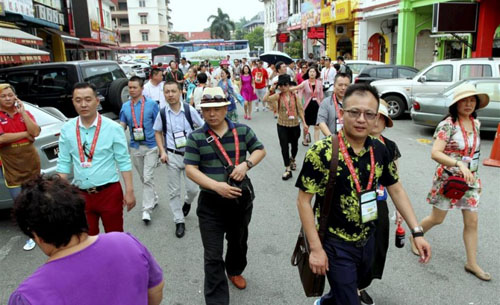According to a Chinese travel site, China’s emerging free independent traveller (FIT) market increasingly shuns escorted travel in favour of spontaneous exploration. And half of them plan to travel more and spend more in the next two years.
More Chinese tourists are travelling on impulse to Malaysia.
Chinese tourists are ready to go on holiday at the drop of a hat – and one of the top countries they travel to is Malaysia.
According to a Chinese travel site, China’s emerging free independent traveller (FIT) market increasingly shuns escorted travel in favour of spontaneous exploration. And half of them plan to travel more and spend more in the next two years.
The top five countries visited by Chinese FITs on their last leisure trip were Japan, Thailand, South Korea, United States and Malaysia. Short-haul destinations in Greater China, North Asia and South-East Asia account for more than 9 in 10 outbound FIT trips.
On average, Chinese FITs have taken 5.5 international trips in their lifetime, higher than the overall average Chinese outbound traveller at 5.2 international trips.
The study by the Chinese travel site metioned above showed that 42% of Chinese FITs said shopping was an important motivation for their trip, especially to North East Asian countries including Japan and South Korea.
With an average spend of ¥6,850 (RM4,241), shopping accounted for the lion’s share of Chinese FITs’ international travel budget regardless of destination.
Second to shopping, Chinese FITs spend an average spend of ¥4,493 (RM2,782) on airplane tickets and ¥3,075 (RM1,904) on accommodation. The average spends on dining for Chinese FITs was ¥2,080 (RM1,288).
Whilst travellers are expecting good shopping options in many travel spots, other factors play a big role in the final selection.
In fact, 56% of this segment are motivated to travel internationally simply by the desire to get away and relax – which seems to be the case especially for travel to South-East Asia – and 47% are lured by the desire to see natural, cultural and historical attractions.
The top three most important deciding factors boiled down to whether a destination was safe or politically stable (65% rated this “extremely important”), followed by whether it featured a clean environment with low pollution (36%), and if it had natural features and landscapes (35%).
The outbound travel season for Chinese travellers kicks off with the May 1st holiday, and peaks at the early-October National Day. Over a quarter (29%) of outbound trips are taken in October, and 77% of outbound trips occur between May and October.
Chinese FITs have a short travel planning cycle with nearly one-third (32%) choosing their destination one to two weeks prior to their departure for their last trip. Nearly one in five (18%) Chinese FITs decide on where to go within less than a week of their departure.
The study revealed that more often than not, China’s FITs are young, well- educated and relatively affluent. Nearly nine out of 10 (89%) Chinese FITs are adults aged 18-44, with 41% of them belonging to the Post-80s generation (aged 25-34). Three in four (77%) Chinese FITs had an undergraduate degree or higher and 44% earned a monthly income of ¥15,000 (RM9,287) or more.
